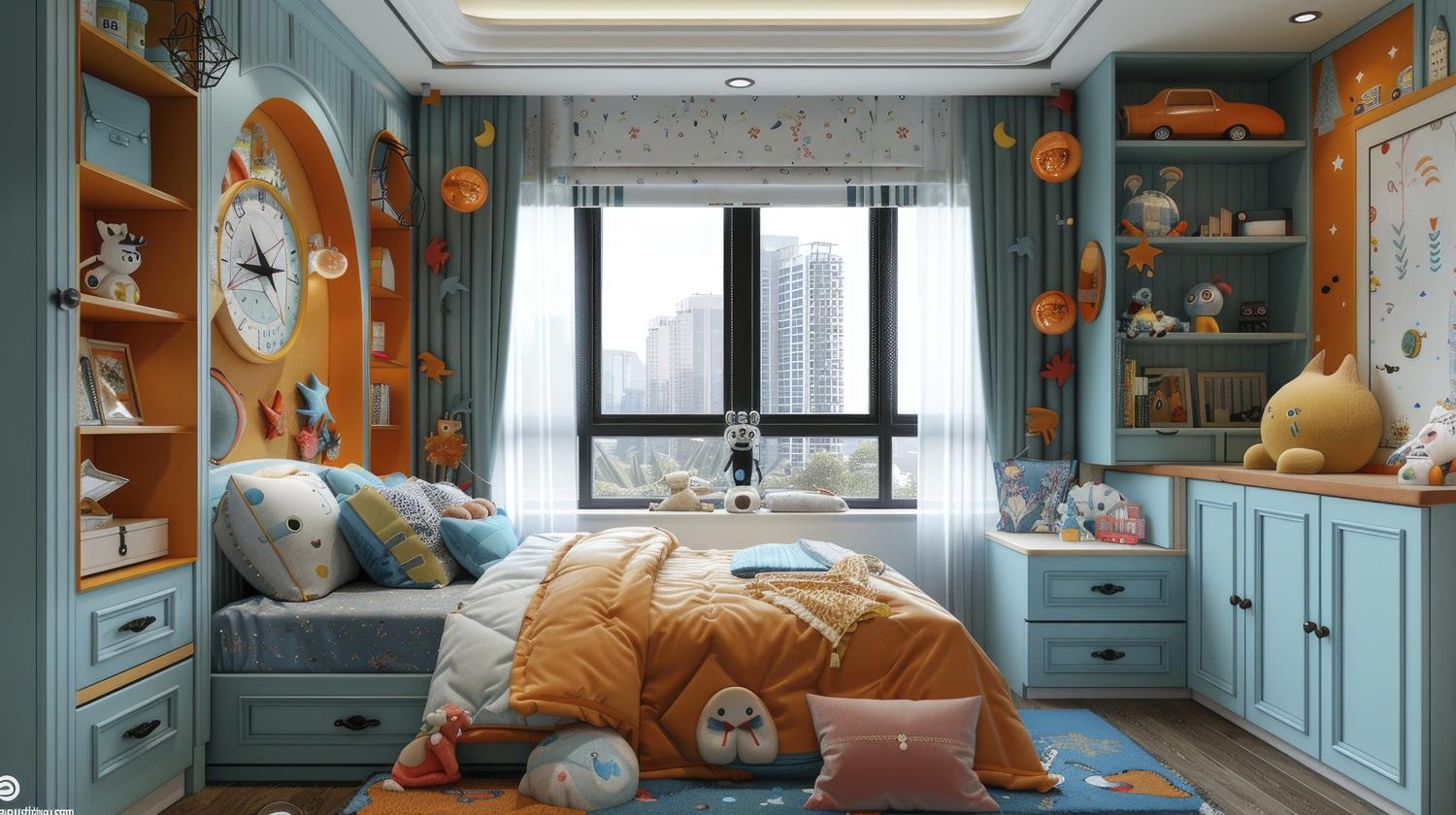Where Style Meets Imagination: Trendsetting Kids’ Bedroom Designs

Designing a child’s bedroom has evolved far beyond choosing a bright wall color and a few cartoon prints. Today’s trendsetting kids’ bedrooms are thoughtful spaces that combine style, creativity, and function — reflecting both a child’s personality and a parent’s desire for longevity, quality, and design harmony. The modern kids’ room is no longer just a place to sleep; it’s a sanctuary for imagination, learning, and self-expression. Our interior designers in Bangalore compiled this article to help you choose from a diverse range of trendy bedroom design ideas for kids.
1. Designing for Growth: Spaces That Evolve
One of the biggest trends in kids’ bedroom design is adaptability. Parents and designers alike are moving away from overly themed, age-specific décor and opting for versatile layouts and furnishings that can grow with the child. Convertible furniture, such as cribs that transform into toddler beds or modular desks that expand as children age, allows the space to remain relevant for years.
Neutral color palettes with pops of personality — through textiles, art, and décor — make it easy to update the look without a full redesign. Think soft greys, warm whites, sage greens, or pale blush tones forming a timeless base. Then, layer in vibrant rugs, whimsical wall decals, or playful bedding that can be swapped out as tastes evolve. This approach saves both money and effort, while ensuring the room remains fresh and inspiring.
2. The Rise of Themed Escapes
Despite the move toward timeless design, themed bedrooms are far from gone — they’ve simply matured. Today’s themes blend sophistication with storytelling. Rather than plastering walls with cartoon characters, designers craft immersive environments that feel both magical and tasteful.
For example, a woodland-themed room may feature hand-painted murals of trees, rattan accents, and natural textures, creating a serene yet adventurous setting. A space-inspired bedroom might use a deep navy palette, glow-in-the-dark constellations, and sleek modern furniture to mimic the cosmos. These themed designs ignite the imagination while maintaining a cohesive and stylish aesthetic.
Customization is key here — bespoke wallpaper, built-in reading nooks shaped like treehouses, or hidden play corners make each space uniquely personal. The best themed rooms strike a balance between fantasy and functionality, giving kids a space that excites their imagination but still works for daily routines.
3. Functional Zones for Play, Study, and Rest
A well-designed kids’ bedroom is a multitasking haven. As children grow, their needs expand — from play to study to rest — and the best designs create clear zones for each activity without feeling cluttered.
The play zone should be open, safe, and easily adaptable. Soft rugs, low storage bins, and sturdy shelving keep toys accessible and encourage independence. Incorporating vertical storage and wall-mounted systems can also maximize floor space for play.
The study area benefits from good lighting, ergonomic furniture, and inspiring décor. A simple desk paired with floating shelves keeps the area tidy yet functional. For shared rooms, consider dual study spaces divided by shelving or color-coded organization to maintain individuality.
The sleep zone should evoke calm. Layered lighting — soft lamps, nightlights, and dimmers — helps transition from day to night, supporting healthy sleep habits. High-quality mattresses and breathable fabrics enhance comfort and promote better rest.
4. Embracing Color Psychology
Color plays a powerful role in shaping mood and behavior, making it one of the most important considerations in kids’ room design. Modern trends lean toward colors that both stimulate creativity and soothe the senses.
Soft greens and blues are popular for their calming and restorative effects, while warmer tones like terracotta and mustard add coziness and energy. Pastels remain timeless for nurseries, but designers are increasingly introducing more sophisticated hues like muted plum, dusty teal, or ochre — shades that can gracefully transition into the teenage years.
Accent walls are making a comeback, especially with textured finishes such as limewash, geometric paint designs, or removable wallpaper. These techniques allow personality to shine without overwhelming the space.
5. Sustainability and Conscious Design
Parents today are more environmentally conscious than ever, and sustainable design principles have found a firm place in kids’ interiors. Natural materials, non-toxic paints, and responsibly sourced furniture ensure a safe environment while reducing ecological impact.
Sustainable doesn’t have to mean boring. Bamboo furniture, organic cotton bedding, cork flooring, and vintage repurposed pieces all add warmth and character. Many designers are also embracing the “buy less, choose well” philosophy — investing in durable, high-quality pieces that will last through multiple childhood stages rather than disposable décor.
Another growing trend is incorporating biophilic design — connecting kids with nature through indoor plants, natural light, and organic textures. Studies show this approach boosts mood, creativity, and well-being, making it perfect for nurturing young minds.
6. Technology Meets Creativity
In an increasingly digital world, technology is becoming an integral part of children’s spaces — but the focus is on balance and creativity. Smart lighting systems that adjust brightness and color temperature, or voice-controlled nightlights and music systems, are practical and fun.
Interactive walls — featuring writable chalkboard or magnetic paint — encourage expression without adding screen time. Some designers are even integrating augmented reality features into murals, where kids can use devices to bring scenes to life.
The key is thoughtful integration: tech should enhance comfort and imagination, not dominate the room. Charging stations and cable management systems can keep tech accessible but organized, preserving the aesthetic flow of the design.
7. Personalized Touches and DIY Elements
A kids’ bedroom should always reflect their individuality. Personalized décor — name signs, framed artwork, or gallery walls displaying their creations — helps children feel ownership of their space. Allowing kids to choose a few design elements, such as their bedding pattern or wall color, fosters confidence and creativity.
DIY touches add authenticity and warmth. Hand-painted wall art, custom-built playhouses, or upcycled furniture pieces make the room feel special and filled with love. Even a simple craft corner with open shelving can encourage children to engage their imagination daily.
8. Small Spaces, Big Ideas
Urban living often means smaller bedrooms, but creativity can make even the tiniest spaces functional and beautiful. Loft beds free up valuable floor area for desks or play zones beneath. Foldable desks, wall-mounted bookshelves, and hidden storage solutions maximize space efficiency.
Mirrors and light-colored walls can make small rooms feel more open, while vertical design elements draw the eye upward, creating a sense of spaciousness. Every inch counts — and in the hands of a thoughtful designer, compact kids’ rooms can be just as inspiring as larger ones.
9. The Future of Kids’ Bedroom Design
Looking ahead, the future of kids’ bedrooms lies in customization, sustainability, and creativity. Design trends will continue to merge aesthetics with emotional and developmental needs, offering spaces that grow alongside their little occupants.
Expect to see more gender-neutral palettes, multi-purpose furniture, and immersive, sensory-driven design. Technology will evolve toward more sustainable smart solutions, and handcrafted, locally made décor will gain further appreciation as families seek meaning and authenticity in their homes.
Conclusion
Kids’ bedrooms are more than just stylish interiors — they’re the first worlds children truly call their own. A well-designed space with the assistance of professional interior designers in India can nurture imagination, independence, and joy, shaping not only how they play and sleep but how they grow and dream.
When style meets imagination, a child’s bedroom becomes a canvas — not just for décor, but for the unfolding story of their childhood.






